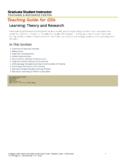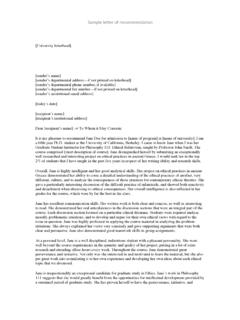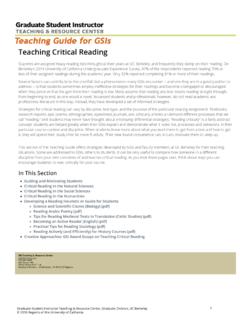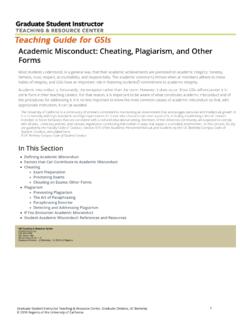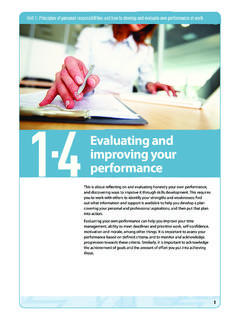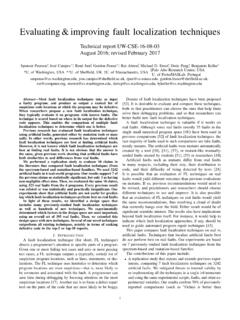Transcription of Evaluating and Improving Your Teaching
1 Evaluating and Improving your TeachingGraduate Student Instructors make an enormous contribution to the Teaching mission of UC Berkeley. That contribution is made possible by GSIs' high degree of motivation as well as their high standards for themselves and their students. This section of the Teaching Guide provides concrete ways GSIs can translate their motivation and high standards into increasingly expert Teaching may also want to consult the Professional Development section of the Teaching Guide, which discusses ways GSIs canconsolidate their Teaching experience into a first-rate professional profile for the This SectionFive Ways to Improve your TeachingConducting a Midterm Evaluation Midterm Teaching Survey -- Numeric (pdf) Midterm Teaching Survey -- Paragraph (pdf) Midterm Teaching Survey -- Short Answer (pdf)
2 GSI Teaching & Resource Sproul HallOffice Hours 9 12, 1 4 Graduate Division, UC Berkeley | 2016 UC Regents Graduate Student Instructor Teaching & Resource Center, Graduate Division, UC Berkeley 2016 Regents of the University of California1 Five Ways to Improve your Teachingby Linda von HoeneBecoming an effective teacher involves seeking out multiple sites of input that can enable you to reflect on and improve theteaching and learning that takes place in your class. This section is designed to provide you with some suggestions about sourcesfor dialogue and methods of with Yourself through a Teaching LogSolicit Feedback from your StudentsDialogue with FacultyDialogue with PeersSeek Outside ConsultationDialogue with Yourself through a Teaching LogOne very important, but often overlooked, source of input on Teaching is you, the teacher.
3 A first step that can form the foundation for other critical reflection is to keep a daily Teaching log or journal on your Teaching . Start by writing your lesson plan on the right-hand side of your Teaching notebook and reserving the left-hand side for comments and reflection. Questions to ask yourself and reflect on in writing might include, What worked well in this class, and why? What didn't, and why? Where did the students seem to have difficulties? Were there any noticeable points where the students seemed very engaged with the material?What types of things may need greater clarification the next time? Were there any particular pedagogical strategies that seemed to work well?
4 What will I change the next time I teach this topic?In addition to informing your Teaching on an ongoing basis, the reflecton fostered by keeping a Teaching log will greatly assist youin writing up a statement of Teaching philosophy for your Teaching further information on how to keep a Teaching log, see:Stephen Brookfield (1995). Becoming a Critically Reflective Teacher. San Francisco: Jossey-Bass, more information about the Teaching portfolio, see:Peter Seldin (2003). The Teaching Portfolio, 3rd ed. San Francisco: Jossey-Bass.(Both items are available at the GSI Teaching & Resource Center.)Solicit Feedback from your StudentsMore often than not, we reflect on (or worry about!)
5 Our Teaching in isolation, without realizing that our own students can be a great source of feedback on the Teaching and learning that takes place in our classrooms on a day-to-day basis. While end-of-semester evaluations tend to summarize the students' overall responses to the class, this type of input comes too late to be of use to you and your students during the current semester. There are several techniques you can use to solicit ongoing feedback from your students on the class in general or the learning that takes place around specific topics and the first couple of weeks of class, ask students to take out a piece of paper and write down three things that have helpedtheir learning in the class and, on the other side of the paper, three things the students would like to change about the class toimprove it.
6 After reviewing their responses, decide what you can and will change and what you either cannot change or findpedagogically unwise to change. You can also let the students know what you will be changing based on their suggestions. Thistype of informal feedback can be gathered at different points over the Assessment Techniques (CAT) enable you to get feedback about the learning that has transpired in a particular class period or after a specific activity. Perhaps the most commonly used CAT is the "one-minute paper," in which students are asked to write down answers to questions such as the following, "What was the most important thing you learned during this class?
7 " and "What questions do you still have on this topic?" This type of technique enables you to find out how the students are processing and synthesizing material as well as which points need to be reiterated or elaborated before going Student Instructor Teaching & Resource Center, Graduate Division, UC Berkeley 2016 Regents of the University of California2 For an excellent discussion of various classroom assessment techniques, see the groundbreaking work:Thomas A. Angelo and K. Patricia Cross (1993). Classroom Assessment Techniques, 2nd ed. San Francisco: Jossey-Bass, 1993.(Available at GSI TRC. Sample CATs can be found on the web.)Dialogue with FacultyThe degree of dialogue between GSIs and faculty about Teaching varies from department to department and from course to course.
8 Many faculty Teaching courses with GSIs hold weekly meetings. These meetings should cover not only course logistics, but also pedagogical strategies for Teaching sections. (Please see the Graduate Council's Policy on the Appointment and Mentoring of GSIs. You should also arrange for the professor you are Teaching with to observe your class. This formative classroom observation should not be a "critique" of your Teaching , but a mutual exchange of ideas, in which both parties discuss Teaching goals, practices, and strategies for improvement. We strongly suggest that faculty and GSIs use a tripartite structure for observations, which includes a pre-observation discussion, a class visit, and a post-observation discussion.)
9 In the pre-observation meeting, you should discuss how the class is going; what you will be Teaching and what pedagogical techniques you will be using; your goals for the class period and what you would like the students to take away from the class; and which areas of your Teaching you would like feedback on. After the class visit, you should meet with the professor to discuss the class and to set goals for those areas of your Teaching that need a concise description of these techniques, see:LuAnn Wilkerson (1988). "Classroom Observation: The Observer as Collaborator." In POD: A Handbook for New Practitioners. Professional & Organizational Development Network in Higher Education: additional articles on classroom observation, see:Karron Lewis, ed.
10 (1988). Face to Face: A Sourcebook of Individual Consultation Techniques for Faculty/instructional , OK: New Forums Press.(Both items are available at the GSI Teaching & Resource Center.)Dialogue with PeersOne of your greatest resources for reflecting on and Improving your Teaching is your peers. GSIs Teaching sections of the samecourse should meet weekly with faculty to discuss ideas on how to teach specific topics, and to exchange materials, resources,and suggestions on how to promote a stimulating learning environment in the classroom. GSIs are also encouraged to pair upwith a peer to do classroom observations. Many GSls who have visited each other s classes have reported that observations anddialogues emanating from this type of peer collaboration provide them with an invaluable opportunity to learn from the teachingstyles and techniques of other GSIs.
